The 2017 KTM 250 SX-F has been on the verge of wining our 250 MX Shootout the last couple years. With some of the key changes KTM made with the 250 SX-F’s chassis in 2017, we might see orange battling for the top spot in our 250 MX Shootout podium. KTM made a few key changes to the 2017 250 SX-F from the 2016 Factory Edition model: The big changes are the 48mm WP AER fork that replaces the mediocre at best 4CS design, the top triple clamp is slightly more rigid to help the SX-F corner more precisely, the outer fork tube thickness decreased 1mm for increased flex in the fork, updated handlebar mounts that are slightly stiffer, aluminum head stays (instead of steel), a softer rear shock spring rate, and a multi switch handlebar mounted map and traction control switch. Traction control on a 250? Yes! We just spent a couple days on the orange mid sized ride, but wanted to give you a quick impression on its character.
Even though the Husqvarna and KTM are very similar, I was surprised to feel that the KTM 250 SX-F’s bottom end power is stronger than the FC 250 out of corners. The SX-F 250’s bottom end is not as exciting as the 2017 YZ250F, but it does have more snap than the FC 250. Smooth and easy to control is the best way to describe the roll on power of the KTM 250. You will have to work the clutch to get out of corners in a hurry and changing the gearing to 14/52 (instead of a 14/51) helps the little orange machine pick up rpm’s more efficiently. Aggressive or faster riders will love the mid to top end as the KTM will pull each gear longer than all of its competitors. The KTM’s engine favors the faster type of rider that likes to rev out the machine. There is also a noticeable amount of a free feeling in the engine (or lack of engine braking) especially under de-cel. The KTM 250 doesn’t get as much pitch as the YZ250F (front to back) when rolling off the throttle. The updated map switch is very easy to use and each map is a noticeable change. The number one map (standard) was the map I used most, as I felt second and third gears had a little more pulling power than map two. Map two (aggressive) had increased throttle response/bottom end, but it revved too quickly through second and third gears. The TC map (traction control) was only noticeable (or made a difference) when we went out of our way to look for the driest most hard pack part of the track. We could see a big advantage with the TC on the KTM 250 SX-F in very slippery low speed off-road conditions; otherwise we feel the TC map works best on the larger KTM 450 SX-F.
We have been testing a lot with the 48mm WP AER fork on the FC and SX-F models lately. As much as it is odd for me to say this, the AER fork actually has comfort when the rider is on the rough line. Yes, that is correct, I am admitting that an air fork has comfort! I have been very critical on air fork technology in the past, as all of the previous air forks that I have tried have failed in my eyes. The AER fork is not yesterday’s air fork. On acceleration bumps where the fork is light and in the top of its stroke the fork is plush and will not deflect. Mid-stroke harshness that plagued the WP 4CS is not as apparent with the AER fork. We started the fork pressure at 10.6 bars and that left us with a fairly comfortable ride but still soft for me on a jumpy track. We ended with a best setting of 11 bars and that held the front end up enough on hard landings and on de-cel. What is so unique about the AER fork is that when you go up in air pressure, the fork action doesn’t get “that” much harsher. Other air forks either dive under braking (soft setting) or when raising the pressures (stiffer setting) gets very harsh through the mid-stroke. It usually is very tough to find a base setting for different types of tracks with other air forks. There is still a little harsh spot on de-cel through the mid-stroke of the KTM 250 fork, but increasing (faster) the rebound up a click or two helps this some. Doing this will let the KTM 250’s front-end feel more planted and get you added front wheel traction. Does the AER fork give you more traction than a spring? No, it still doesn’t give you that real positive feeling on lean angle (like a KYB SSS fork), but WP has gave all of us riders hope in air fork technology with the AER setting. We set the sag on the shock at 106mm and it felt like it gave a nicely planted/squatted feel out of corners. It is a little soft for heavier 250F pilots over 170 pounds, but stiffening the high speed compression a half a turn and increasing low speed compression a couple clicks helps hold the rear end up on jump faces/landings. Once you do this it will take a little forward bite out of the rear end on choppy acceleration bumps, but the trade off you get up jump faces/landings is worth it.
The chassis of the 2017 KTM 250 SX-F feels light, especially on tight tracks. Straight-line stability is good and the frame absorbs a lot of what the track gives you. Once the track gets choppy and square edged the KTM 250 doesn’t give you a rigid/harsh feeling as some other aluminum styled mx machines. You can feel the chassis absorb even the hardest of hits, which was great on my older joints. Cornering is great as the KTM leans into a rut nicely and allows you to continue the lean through mid-corner. It doesn’t want to stand up once you’re inside a tight line and it doesn’t take much effort from the rider to get there. The ergonomics of the KTM 250 SX-F is more of a “sit on top” feel and the handlebar is a nice shape without too much sweep.
The 2017 KTM 250 SX-F had only a few minor changes to it, but with the fork improving dramatically, this could really shake up the 2017 250 MX Shootout. The added suspension comfort, balanced chassis, and lightweight cornering feeling ability, we could see the KTM climb up the ladder in the final rankings. The only thing we would love to see is a little more torque out of the engine. If KTM gave us that the other manufacturers would be in for a big wake up call.
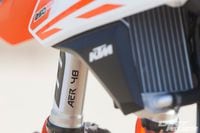
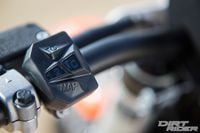
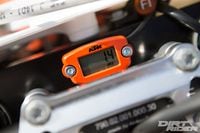
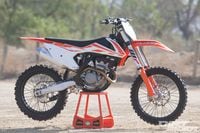

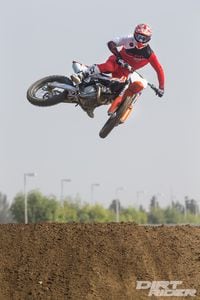
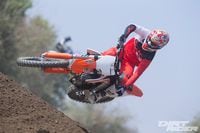
/cloudfront-us-east-1.images.arcpublishing.com/octane/IYHM55XRNVHF3DSS3467PZ7ONQ.jpg)
/cloudfront-us-east-1.images.arcpublishing.com/octane/L7K3FIINEBHMZI2TXTUE4FXH7I.jpg)
/cloudfront-us-east-1.images.arcpublishing.com/octane/XE7P5YXNZZDUTIGW4YNWQRDVY4.jpg)
/cloudfront-us-east-1.images.arcpublishing.com/octane/AV55DOHQ3BEXJLPWR6UWLYUSAQ.jpg)
/cloudfront-us-east-1.images.arcpublishing.com/octane/MMROGOYHXZAYDC4RKIDJ4VRSGA.jpg)
/cloudfront-us-east-1.images.arcpublishing.com/octane/FHRWLPEOTBFOHFTQLIHJNIXCFQ.jpg)
/cloudfront-us-east-1.images.arcpublishing.com/octane/J2RUDOXTOZHBXOFCUQKBAGBMAQ.jpg)
/cloudfront-us-east-1.images.arcpublishing.com/octane/UDQASRGJ3ZDG3BANXWU6P5NIQY.jpg)
/cloudfront-us-east-1.images.arcpublishing.com/octane/YIICVWCT7FDURLJQ2H4AIMXLOY.jpg)
/cloudfront-us-east-1.images.arcpublishing.com/octane/SKYGGQY3XJCPDAM4CUHUXBS444.jpg)
/cloudfront-us-east-1.images.arcpublishing.com/octane/AONOEIBHJBGMBOCD5HBWVB3UAI.jpg)
/cloudfront-us-east-1.images.arcpublishing.com/octane/76O4I66VBNBS5GXX4DNHXXKHR4.jpg)
/cloudfront-us-east-1.images.arcpublishing.com/octane/3LSXOLSH3NEJDBMO3JZ6CYMK5M.jpg)
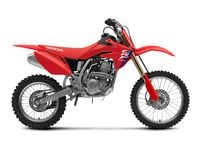
/cloudfront-us-east-1.images.arcpublishing.com/octane/QNIQ2A4UEBGNRKB4STEBJPMUX4.jpg)
/cloudfront-us-east-1.images.arcpublishing.com/octane/35SLCX4NQ5AFTHU6EY7FJSNGEY.jpg)
/cloudfront-us-east-1.images.arcpublishing.com/octane/LVH6MQASTRA2RJ74WY2PM7OAFI.jpg)
/cloudfront-us-east-1.images.arcpublishing.com/octane/TDBZ2JZJ7ZBNBLMB677WNPFLJE.jpg)
/cloudfront-us-east-1.images.arcpublishing.com/octane/3JLESTQC3RFDNBJBXT4OMYU65Q.jpg)
/cloudfront-us-east-1.images.arcpublishing.com/octane/4OOTARNHZRFEJJ5ZPVQMG3H6FE.jpg)
/cloudfront-us-east-1.images.arcpublishing.com/octane/MF32EN5WZNAEXCNYDYFNKMC2AE.jpg)
/cloudfront-us-east-1.images.arcpublishing.com/octane/UGLO3U37HJHGLM22F3D4XOWNVE.jpg)
/cloudfront-us-east-1.images.arcpublishing.com/octane/WSK35AT3LBBH7GZSXAXXREGF6U.jpg)
/cloudfront-us-east-1.images.arcpublishing.com/octane/OXEZZUYKDJHFVB4K7AIQSLRR7M.jpg)